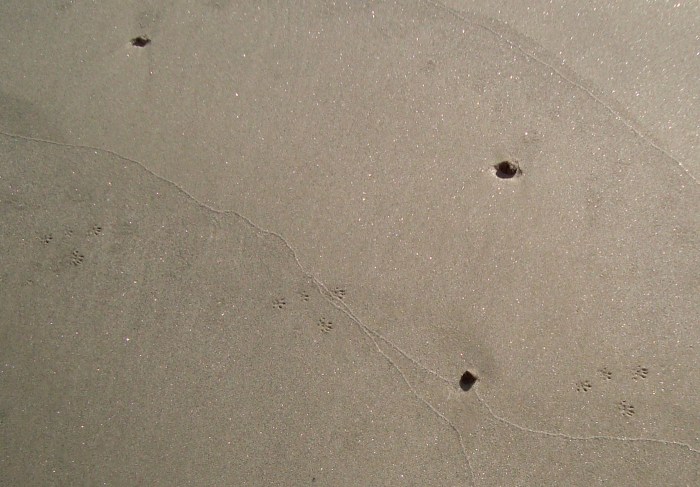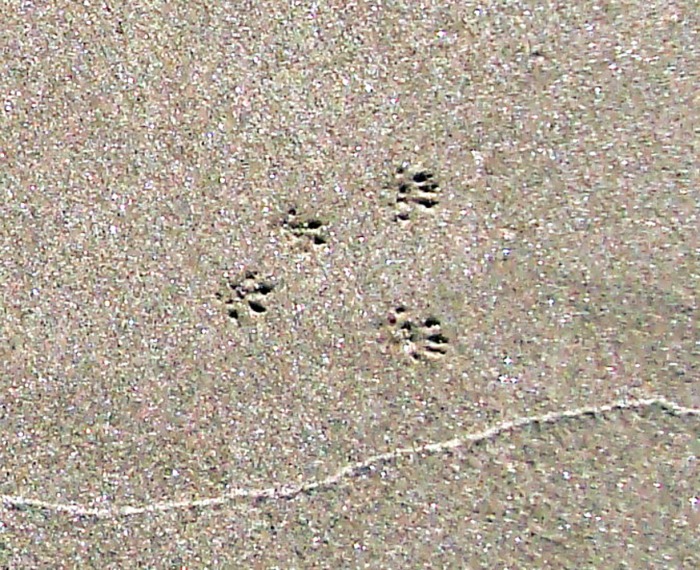Anyone have any idea what leaping little creature made these tracks on the beach?
Bounding is done by animals with relatively long bodies. The animal springs forward like a slinky-toy releasing itself, and all four feet come down in the same general area, and then they repeat the operation, leaving clustered prints in widely separated groups, as shown above. There are plenty of bounding animals — weasels, minks, otters, and many more. However, in our backyards most of us will only see the tracks of two kinds of bounders — chipmunks and squirrels. And they don’t always bound.
Prints of chipmunks and squirrels often show claw marks, but sometimes the claws don’t show at all. (from backyardnature.com)
E.J. Lefavour



Ask any digger, and the answer is steamer or chowder clams. When you go digging for steamers, you look for the holes, preferably a grouping, and dig. Dan Molloy, my clam guru, taught me the basics: “It’s a vision thing.” You have to look for the holes under the surface ones, and dig in the direction that leads from one clam to the next.
LikeLike
No, I don’t think that’s it. These prints are made by a very small four footed creature with claws (much smaller than a squirrel), and they were in the sand at the top of Cambridge Beach, not near the waterline. But it is something that leaps, as each set of prints is a pretty long distance from the prior set, for something with feet that small.
LikeLike
Are you talking about the tiny footprints in the lower right, or the three big holes? I know the big holes are clams.
LikeLike
The three sets of footprints are coming in from the left center and heading out toward the bottom right of the photo. What looks like three holes are actually 3 small rocks casting shadows on the sand.
LikeLike
OK, with magnification I can see the rocks and the other sets of bird footprints. We need Mass Audubon to help ID.
LikeLike
Yes, I see three rocks, or …(clam holes) casting shadows.
I think any digger would say the tracks are that of a Weasel,
which can be steamed and made into chowder.
LikeLike
Weasel chowder – yuck! But the prints are much too small for a weasel. All together the 4 footprints are about the size of a half dollar. The rocks are really just little pebbles.
LikeLike
We also need some eyeglasses for Fredrik…
LikeLike
Fredrik has reading glasses, but in this case, were not enough. However, I know there are clams down there. My favorite way to cook weasel is on the grill, smothered with Bumbee tuna.
LikeLike
with out without the boiled human parts?
LikeLike
Looks like weasel tracks to me!
LikeLike
probably a mouse:
http://www.bear-tracker.com/deermous.html
LikeLike
Maybe a jumping mouse? The size looks right, and they hold their tails erect when they jump so they wouldn’t leave a tail drag mark.
LikeLike
I like the deer mouse info, but this one is really leaping, as EJ says. Most mice — deer mice included, just scurry along, maybe dragging their trails. Except for the wireless mice, which leave no trace (you can tell the difference, because the wireless ones don’t eat toilet paper or air filter material). On the other hand, you do have to change their little batteries.
LikeLike
I liked the jumping mouse but when I looked up its tracks in Mammal Tracks and Signs, they have much longer toes and a different gait and their habitat is woods and fields. I really have never seen a set of tracks like these before and I am pretty observant of nature and wildlife. I really can’t imagine any mouse or tiny rodent running across a beach. Too exposed to predators.
LikeLike
Now I think that was the four footed weasel clam. It makes excellent chowder!
LikeLike
Chipmunk?
LikeLike
I think we would need a more detailed picture to be sure, it is even hard to tell how many toes there are. Five toes front and hind would indicate a member of the weasel family. Four front and five hind would be rodentia. A measurement of the size would also be helpful. Mass Fisheries and Wildlife has a downloadable guide http://www.mass.gov/dfwele/dfw/wildlife/publications/tracks_guide.pdf
LikeLike
I’ve included a closeup high contrasted sharpened print, and it really appears (on all of the prints, not just this one) that there are 3 toes forward.
LikeLike
You all have just created a new character for a Bong Tree Island adventure! Love the conversation!
LikeLike
The next book has been started, and this little morphing creature just might get in there.
LikeLike
What a quirky little conversation. l’m surprised Paul M. and RD haven’t chimed in.
LikeLike
I didn’t want to post Rubber Duck’s idea that it is a mouse who ate mexican jumping beans because she’s a bit clueless.
If it is a Bong Tree Island inhabitant then there is a trans species type deal in the family tree right? I think granpa mouse and a super ball had way too much fun in the past.
LikeLike
I love it! I was waiting for your input, knowing it would probably be the craziest and most appropriate for Bong Tree Island – a bonging mouse that mated with a super ball. I don’t think of rubber and live creatures mating, but then RD and homie did set a precedent.
LikeLike
“… RD and homie did set a precedent.”
Rubber Duck and Homie are nodding their heads.
LikeLike
How about some tiny frog-like creature? They hop.
LikeLike
OK, when in doubt refer to your Peterson’s Guide to Animal Tracks and stop all the fun and speculation; White footed mouse or Deer Mouse:: ‘…the usual sign is a four print pattern; the leaping pattern may be confused with that of a house mouse; they live in holes in plowed furrows, among rocks, and on ocean beaches.’
LikeLike